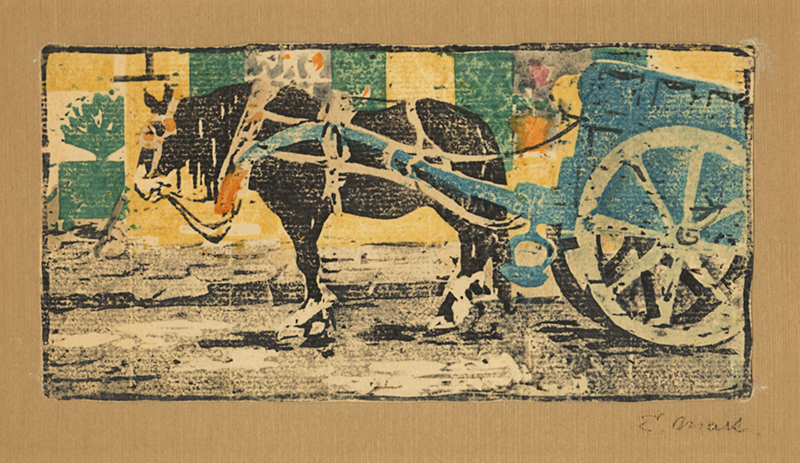Old Horse is a color woodcut from about 1907 by American expatriate, Ethel Mars. It was printed by the artist on a thin, ivory laid paper that has been tipped onto a support sheet of tan wove paper which is pencil signed in the lower right under the image. The support sheet is further supported by a brown paper which bears the title of the color woodcut in the lower right corner as well as on the verso. Old Horse is a proof from an unstated edition and is considered quite rare. The paper was trimmed to the image and both measure 4-1/8 x 8-1/2 inches.
Old Horse shows elements of what would become the white line woodcut technique. Using a small format, Mars struck the balance between retaining fine details and minimizing clutter through the use of uninked or negative space. In this composition she chose an otherwise unremarkable scene, incidentally capturing a notable pre-World War I element of daily life in the city. An old horse and cart rest beside an apartment building on a cobblestone street and, between the horse and its burden, a terracotta pot holding pink flowers rests on a windowsill.
Ethel Mars, painter, printmaker, and children’s book illustrator, was born in Springfield, Illinois on 19 September 1876 to Adelia and Alonzo Mars. After attending the McClernand Grade School, Mars secured a scholarship to the Cincinnati Art Academy, where she studied with Frank Duveneck and Lewis Henry Meakin. At the academy, she met fellow artists Edna Boyes Hopkins and Maud Hunt Squire, who would become her lifelong companion.
Mars and Squire worked independently as book illustrators after graduating from the Cincinnati Art Academy. They first traveled to Europe together in 1900 and after that they worked together on illustrating Children of Our Town by Carolyn Wells and Adventures of Ulysses by Charles Lamb. In 1904, they visited Munich and it was there that Mars learned the techniques of color woodcut. They moved to Paris in 1906 and Mars was elected to membership of Salon d'Automne and the Société de Beaux-Arts. She and Squire were part of Gertrude Stein’s circle and, in 1907, Stein immortalized the women in her early word portrait, Miss Furr and Miss Skeene. Mars’ painting Woman with a Monkey won the “Best Painting by a Woman” award in 1910 from the Society of Western Artists.
Mars first worked as an ambulance driver at the beginning of World War I but, fearing for their safely, she and Squire left Paris for America and settled in Provincetown, Massachusetts. In 1915, Mars’s international reputation attracted other artists to this seaside town and an artists’ colony emerged. Ethel Mars, along with Blanche Lazzell, B.J.O. Nordfeldt, Ada Gilmore, Mildred McMillen and Maud Hunt Squire were part of the original group of artists known for their white line woodcuts, called Provincetown prints. Blanche Lazzell wrote, “To be in Provincetown for the first time in those days, in the summer of 1915, when the whole scene, everything and everybody was new, it was glorious indeed…creative energy was in the air we breathed.”
At the conclusion of World War I, Mars and Squire returned to France, settling in Vence in the southern part of the country. By 1925 they were active in an artists’ colony that included Marsden Hartley, Yasuo Kuniyoshi and Chaim Soutine. Mars discontinued printmaking and resumed painting and drawing, exhibiting in the major Paris salons.
During World War II, Mars and Squire went into hiding near Grenoble, France where Peggy Guggenheim planned to open a museum of modern art. After the war, Mars continued to draw, concentrating on portraits and large-scale autobiographical watercolors and portraits of her friends and surroundings. Ethel Mars died on 23 March 1959 in Vence, France.



